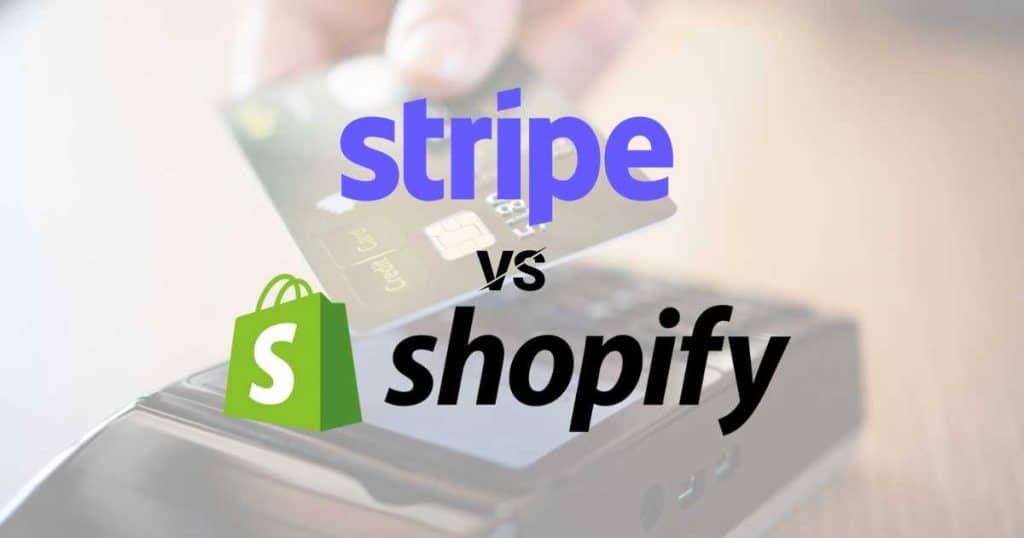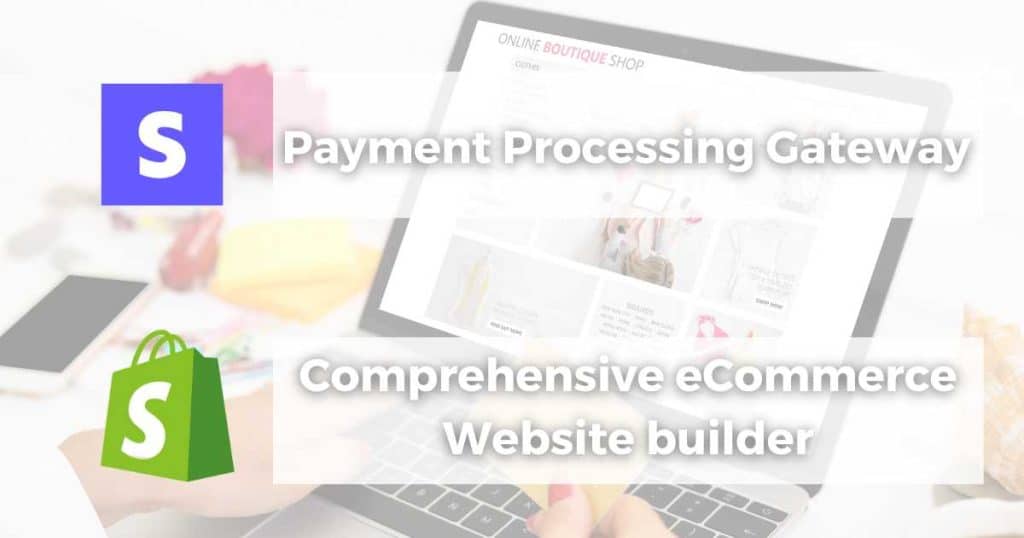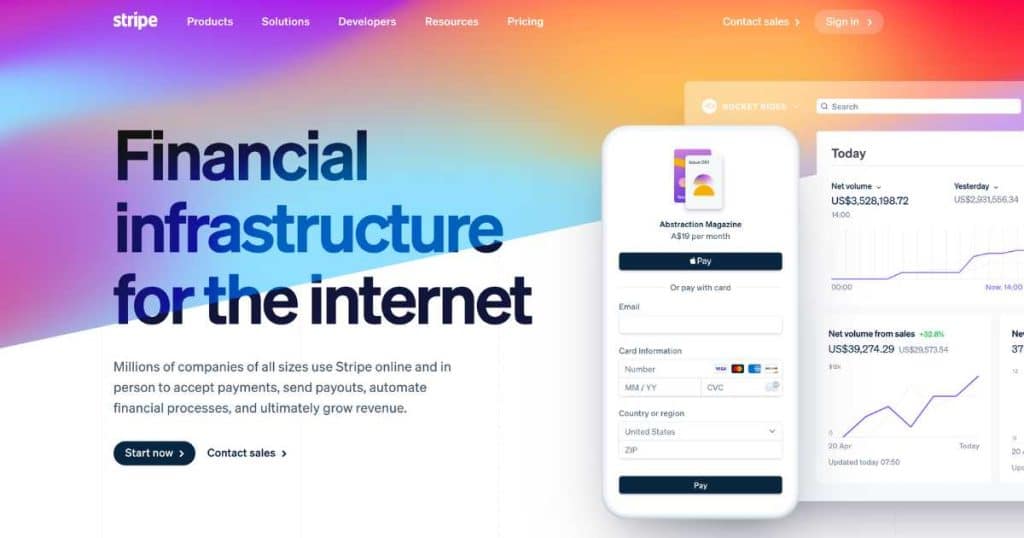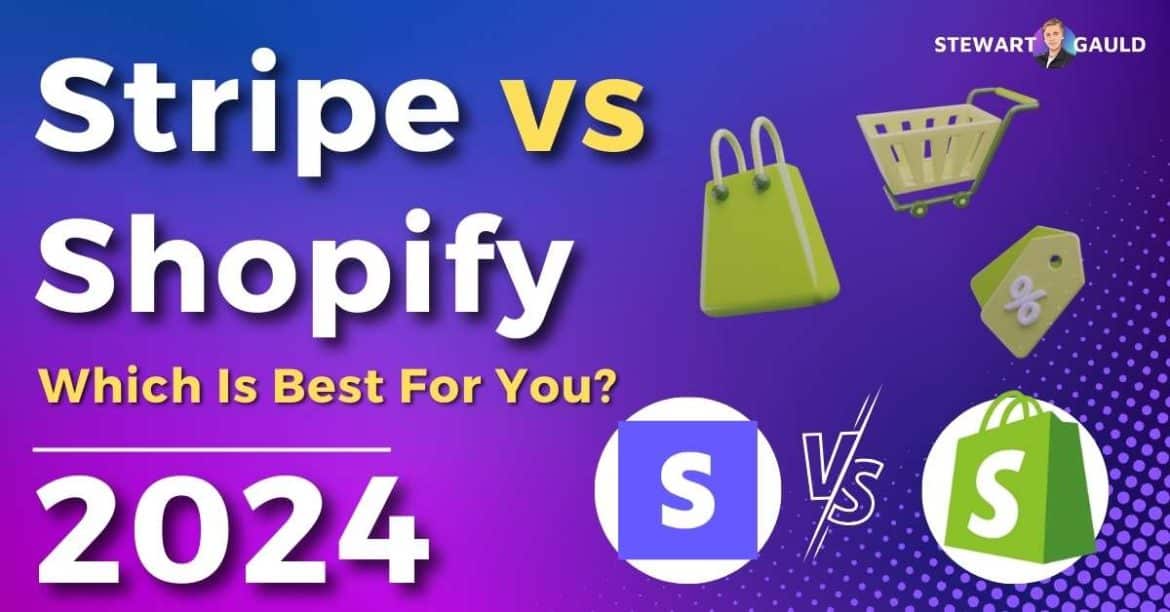Are you wondering what the difference is between Stripe and Shopify and which you should use for your eCommerce business?
You’ve probably heard of Stripe and Shopify, two prominent eCommerce tools for online businesses.
Both allow you to accept payments, but what else can they do?
Whether you’re after a fully-fledged eCommerce website builder, a payment processing platform to accompany your online store, or both – stick with me!
I’ll guide you every step of the way to figure out – which is best for you?
Quick Summary
- Stripe is a payment processing platform, whereas Shopify is a total eCommerce platform that helps you build and manage your online store.
- Shopify offers a built-in payment processing feature called Shopify Payments, which is like a basic version of Stripe.
- Use Stripe when you need a highly customizable online payment processing platform for your WordPress, WooCommerce, BigCommerce, or Squarespace store.
- Shopify Payments is the cheapest and best option if you already have a Shopify store.
- You can learn more about Stripe and Shopify through my how-to video guides here.
Stripe vs Shopify 2024

Stripe and Shopify are known for being innovative online eCommerce solutions.
But did you know that they’re actually quite different products with distinct features and functionalities?
So, what is the difference between Stripe and Shopify? And which is the best choice for your business?
Well, this is where I step in.
Read more: How To Sell Your Products Online?
What Are They? Stripe vs Shopify
Stripe is a leading online payment processing gateway that allows businesses to effortlessly and securely accept and process transactions on the Internet.
The platform provides a suite of tools and APIs that simplify the payment process, such as recurring billing, fraud detection, and subscription management.
Additionally, Stripe supports various payment methods, including credit and debit cards, digital wallets, and mobile payment options.
Shopify takes a different approach, primarily serving as an eCommerce platform designed to support businesses in building and managing their online stores.
It provides a range of features like website customization, product listings, inventory management, payment processing, order fulfillment, and marketing tools.
With Shopify, businesses can create a professional-looking online store without learning an ounce of code!
Read more: How To Use Stripe?
What Are The Differences Between Stripe vs Shopify?

The biggest difference between Stripe and Shopify is, of course, their functionality.
- Stripe is a reputable and reliable service that ensures the secure processing of transaction fees, allowing you to receive payments smoothly.
- Shopify offers a comprehensive ecosystem for creating and managing an eCommerce store, enabling you to sell your products effectively.
However, Shopify offers an in-house payment processing service called Shopify Payments.
It wouldn’t be fair to compare Shopify as a whole to Stripe, as they’re simply quite different.
So, I guess the real question is: What are the key differences between Shopify Payments and Stripe?
Read more: Do You Need an LLC For Shopify?
Stripe vs Shopify Payments Differences
Although Shopify Payments and Stripe share similarities, they’re not identical!
Shopify Payments is ideally suited for business owners who’ve already built an online store with Shopify.
While you can use a third-party payment processing service like Stripe or PayPal on Shopify, you’ll be stung with transaction fees.
But with Shopify Payments, those transaction fees are significantly reduced.
Like I said, Shopify Payments can only be used with Shopify stores.
Stripe, however, is a versatile and highly customizable payment solution that can be used regardless of whether you have a Shopify store or not.
Stripe vs Shopify Pricing
Stripe:
Stripe charges a pay-as-you-go set fee per transaction pricing model with no hidden or monthly fees.
The standard pricing rate per transaction is 2.9% plus a 30 cents per successful card charge.
International payments and currency conversions will incur additional costs.
Shopify:
There are no transaction fees for Shopify Payments, but you’ll still need to pay the normal monthly pricing fee plan costs, which are as follows:
- Basic: $29 per month.
- Shopify: $65 per month.
- Advanced: $399 per month.
However, if you run an online store with Shopify and use a third-party payment processing platform like Stripe, you’ll get charged a transaction fee of either 0.5, 1, or 2% (depending on your plan).
They’ll also charge you for accepting credit card payments in your store (prices vary depending on your plan).
Winner = Shopify.
Read more: Shopify vs Etsy.
Ease Of Use
When it comes to ease of use, Stripe and Shopify Payments both offer unique advantages.
Although Stripe is relatively easy to use, the level of customization is more suited toward technical users or people who want more control over their payment processes.
I believe that some users without coding knowledge may find it more challenging to navigate.
On the other hand, Shopify (and Shopify Payments) focuses on user-friendliness and accessibility.
Although feature-rich, Shopify is renowned for being user-friendly, even for beginners!
Simply customize your online store with their easy-to-use drag-and-drop editor, and sit back, relax, and watch Shopify take care of hosting and security for you!
Shopify payments seamlessly integrates with Shopify stores, allowing you to set up and manage your payments right within your online store.
With its intuitive interface and simplified setup process, Shopify is an excellent option for beginners or non-technical users.
Winner = Shopify.
Read more: How To Collect Online Donations For Free?
Customization
If you’re looking for a highly customizable, flexible, and scalable solution for online stores, then Shopify is your right-hand man.
However, how does Shopify Payments stack up compared with Stripe regarding customization?
Well, Stripe and Shopify Payments each offer different levels of customization when it comes to payment processing.
Stripe is highly customizable, allowing businesses to create tailored payment forms and embed payment buttons and other custom elements.
It’s a developer-friendly platform, so it’s no surprise that it can easily adapt to complex business requirements!
On the other hand, Shopify Payments is designed to work seamlessly with Shopify stores, offering basic customization options via the Shopify admin panel.
While it may not be as customizable as Stripe, it is an excellent choice for businesses that prioritize having a customizable storefront over a tailored checkout experience.
Winner = Stripe.
Read more: Magento vs Shopify.
Stripe Key Features

Stripe offers a more comprehensive and flexible solution than Shopify Payments (which focuses solely on payment processing for Shopify members).
So, what are the key features within Stripe that I keep talking about to make it so versatile?
Firstly, Stripe lets you accept various payment methods, including digital wallet transactions, ACH payments, and credit and debit card payments.
You can also connect your Stripe account with multiple popular online store builders such as Shopify, BigCommerce, Squarespace, and WooCommerce.
Additionally, Stripe offers a wide range of pre-built and customizable payment solutions, which can be divided into three main categories:
Online Global Payments:
Stripe’s online services for global payments include payment processing, checkout management, customizable payment user interfaces, payment links, and fraud and risk management tools.
Additionally, Stripe also offers dynamic subscription and billing management tools, online invoicing, terminal solutions, financial connections, and online identity verification.
Automation Tools For Revenue and Finance:
Stripe provides custom reporting tools, data pipelines, revenue recognition, tax and VAT automation, and total invoicing and billing solutions.
Banking as a service:
Additionally, you can use Stripe’s ‘Stripe Connect’ feature to integrate your financial services and payments onto your website or marketplace.
For eCommerce businesses, the Global Payments ecosystem will be the most beneficial for you!
Stripe allows any business type to accept the following payment options:
- Credit and debit cards (Mastercard, Visa, American Express, Discover, etc).
- Digital wallets (Google Pay, Apple Pay, Microsoft Pay, etc.).
- ACH debit and credit transfers.
- Wire transfers.
- Buy now, pay later services (Klarna and Afterpay).
- Local and international offline payments.
Stripe operates in over 30 countries and has payment processing options in over 135 currencies.
Basically, the opportunities are endless with Stripe!
I know what you’re thinking……what about offline payments?
Simply leverage Stripe’s in-person POS tool, Stripe Terminal, for a cohesive customer experience.
Read more: Ecwid vs Shopify.
Shopify Payments Key Features

As I mentioned earlier, Shopify Payments is an exclusive payment processing option for eCommerce teams with Shopify stores.
Included in all Shopify plans, Shopify Payments eliminates the need to integrate a third-party payment provider.
This is the way to go if you want to avoid pricey third-party transaction fees!
With Shopify Payments, you can simply process payments online and in person using Shopify stores or Shopify’s handy POS tools.
The payment gateway seamlessly integrates with over 100 payment providers, is available in 22 countries, and supports over 130 currencies.
Shopify Payments accepts many payment types, such as:
- Credit and debit cards.
- Digital wallets such as Google Pay, Apple Pay, Microsoft Pay, etc.
- Online payment tools like PayPal.
- Local and international payment methods.
- Manual payments (using card reader tools and terminals)
Both Shopify Payments and Stripe are PCI compliant and include fraud protection tools, fraud filters, and other resources to safeguard businesses.
But Shopify Payments offers fewer implementation options than Stripe because it is solely intended for Shopify store owners.
There are multiple ways that you can accept payments, such as:
- Through your customized Shopify checkout page.
- Embedded purchase links on your site
- Social media channels (that have been integrated with Shopify).
- Shopify-approved card readers, terminals, and POS tools.
Read more: How To Remove Powered By Shopify On Your Website?
Shopify Additional Tools

As mentioned, Shopify is so much more than just an eCommerce payment processing tool.
For starters, you can build a fully functional and customized online store with Shopify’s wide range of free and paid themes.
Although Shopify isn’t free, all plans come with unlimited products and bandwidth, abandoned cart recovery, and, of course, the ability to sell both physical and digital products.
Shopify provides advanced inventory management capabilities, such as tracking stock levels and organizing product catalogs into collections or sub-collections.
With automated shipping rates and tax handling, multiple shipping choices, and incredible customer and inventory management, you have a complete 360-degree view of your store!
But that’s not all!
Shopify allows for multichannel selling on popular platforms such as Instagram, Facebook, Amazon, and eBay and even has its very own built-in email marketing tool.
Plus, their inventory management capabilities are remarkable, allowing you to quickly track sales across multiple selling channels to avoid stockouts.
With real-time updates, discounted rates from suppliers, and free shipping options, Shopify goes above and beyond to ensure your customers are well taken care of.
Shopify is so much more than a payment processing provider. In fact, Shopify is so much more than just an eCommerce website builder!
Read more: Google Analytics Integration For Shopify.
Stripe vs Shopify Customer Support
When it comes to customer support, the battle between Stripe vs Shopify is a close one!
Stripe provides 24/7 customer support through chat, email, and phone, and technical support is available (on a separate developer chat community) at all times.
With Shopify, customer support is included with all plans, and all members receive 24/7 customer support through email and live chat.
Furthermore, you can reach someone through around-the-clock phone support if you have the Basic Shopify plan or above!
Both platforms prioritize providing excellent customer service, so I’ll call this a tie!
Winner = Draw.
Read more: Is It Better To Use Shopify or Wix?
Who Are They Best For? Stripe vs Shopify

Okay, so which is best for you?
Firstly, if you don’t already have an online store, I suggest going with Shopify and setting up Shopify Payments.
Shopify is an awesome premium eCommerce website builder and an all-around excellent tool for beginners looking to grow and scale their businesses.
Additionally, if you already have a Shopify store and simplicity is your priority, Shopify Payments is a no-brainer.
Basically, using Shopify Payments is a user-friendly, cost-effective solution!
However, if a tailored payment experience is pivotal for your business, go with Stripe’s robust APIs and highly customizable functionalities.
And if you’re not using Shopify as your eCommerce platform, Stripe might be a better option for you as it can seamlessly integrate with various other website builder platforms.
Or here’s another thought: what if I told you you could use them both?
If you already have a Shopify store but want the flexibility of Stripe’s highly customizable capabilities, why not integrate them together to get the best of both worlds?
Stews Final Thoughts
And that is everything I wanted to cover in this Stripe vs Shopify comprehensive guide!As you can see, comparing the two can be challenging because they essentially do different things.
However, I hope you can now identify which platform is the best for you (or if using both is your best bet?)
Regardless of what eCommerce platform you choose (and there is no ‘right’ choice), you’ll be in capable hands!
Thanks so much for reading.

